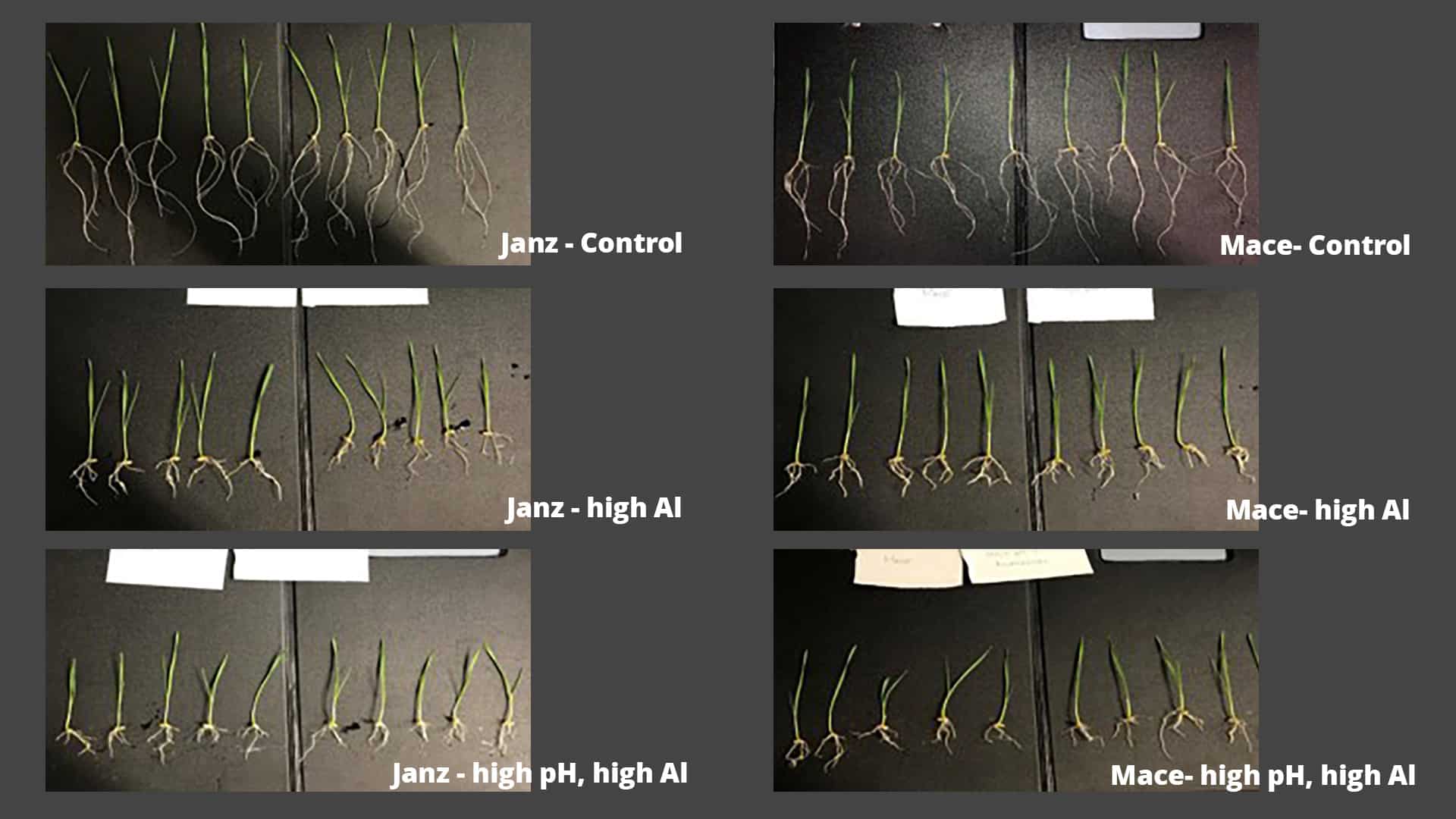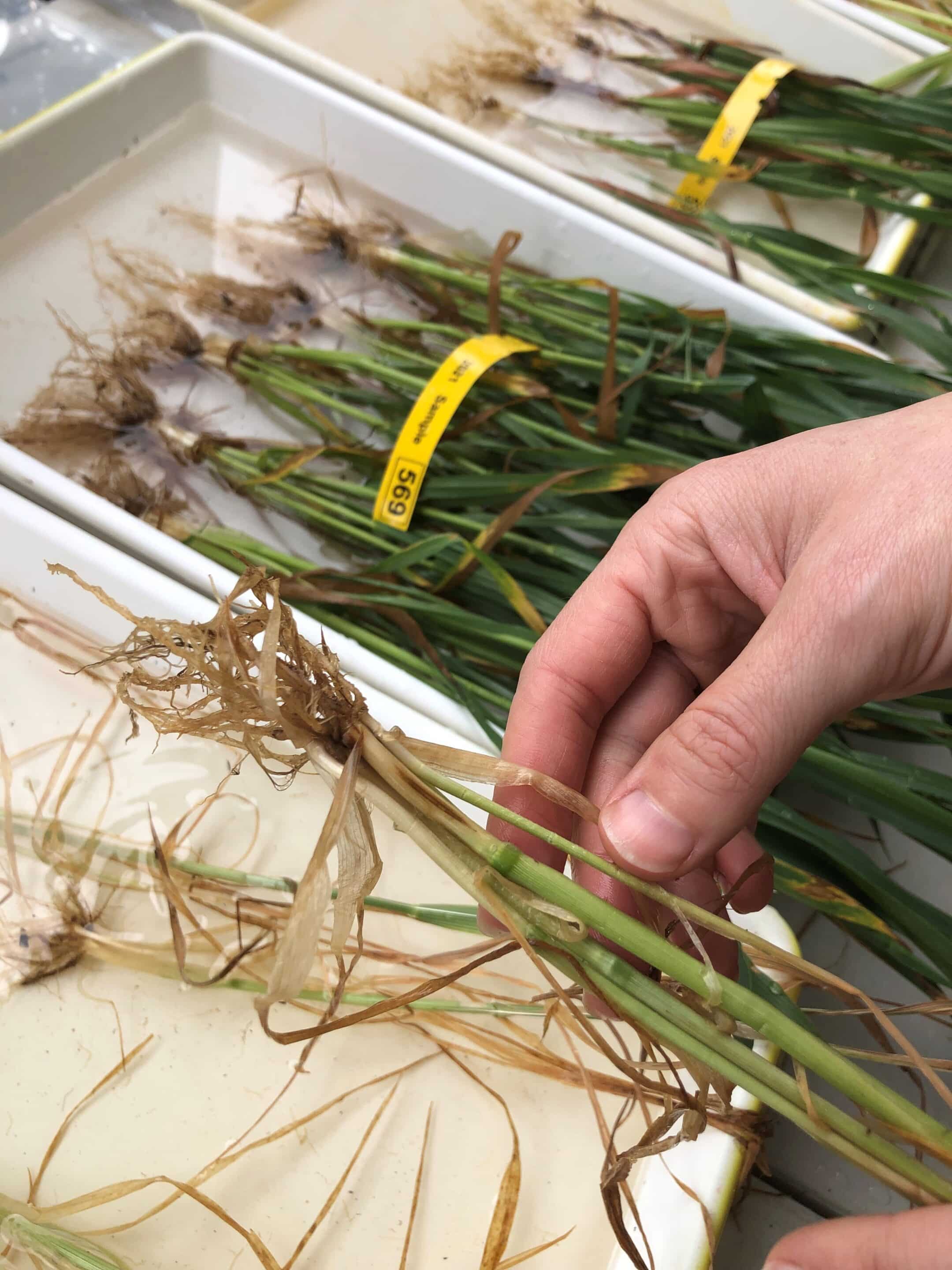START
FINISH

Summary
To identify the specific aluminium speciation (the distribution of aluminium forms within the system) that accumulates in South Australian sodic soils, soil samples were collected at 0-20, 20-40, 40-60, 60-80 and 80-100 cm depths, and sent to the Canadian Light Source (CLS) synchrotron for analysis.
Two wheat cultivars were grown hydroponically in control, high pH and high pH + aluminium solutions and analysed for root biomass in SA and aluminium speciation in the root tips was also measured at CLS.
These confirmed the toxic effects of high pH and high pH + Al on wheat roots and identified the specific aluminium speciation present.
Background
Evidence suggests aluminium (Al) toxicity in alkaline soils is a major inhibitor to wheat root development in South Australia. However, a lack of knowledge around the specific Al speciation accumulating in alkaline soils and plant roots has been holding back research into the role Al toxicity plays in inhibiting root growth, and therefore the breeding of wheat varieties with improved tolerance traits for local sodic soils.
Recent advances in synchrotron-based x-ray technology provided a new opportunity to identify the specific form of aluminium in alkaline soil and wheat root tissue samples, so this research bottleneck could be cleared.
Research Aims
The core objective of this project was to use advances at the Canadian Light Source synchrotron, University of Saskatchewan, to:
- Determine the form of aluminium occurring in an alkaline SA soil profile (to 1 metre depth).
- Measure the spatial distribution of this form of aluminium in wheat roots grown under control, high pH and high pH + aluminium conditions.
In The Field
Soil samples were collected at Roseworthy at depths of 0-20, 20-40, 40-60, 60-80 and 80-100 cm. These were dried and ground, before 5g samples of each were sent to CLS for testing on the Spherical Grating Monochromator (SGM) beamline, along with aluminium phosphate, aluminium oxalate and copper tape control samples.
Meanwhile, replicates of the bread wheats Mace and Janz were grown hydroponically under controlled environment growth chamber conditions. Mace is considered tolerant high pH with high aluminium and Janz is considered sensitive, and the plants were grown in control (pH 7.5), high pH (pH 9.2) and high pH (9.2) plus aluminium (1 mg/L of Al) solutions. The pH of each solution was maintained morning and night, using sodium carbonate (Na2CO3) or hydrochloric acid (HCl).
Five days after germination the plants were removed and weighted to obtain fresh shoot and root weights. Five plants from each group were rinsed in a weak calcium chloride solution (1mM) and four one-centimetre root tips were cut from each plant. These were then freeze dried and shipped to CLS for analysis.
Results
Plant growth in the hydroponic experiments was uniform across the replicates in each treatment. The shoot biomass of Mace was higher than Janz in the control and high pH treatments but shoot biomass was similar in the high pH + Al treatment.
Root biomass was significantly reduced in the high pH and high pH + Al treatments. The more tolerant Mace replicates developed larger roots than Janz.
The spectra generated from both soil and root tissue analysis included a double peak that is a unique and distinguishable feature of the boehmite form of aluminium. The results suggest the presence of other forms or combinations of aluminium may be likely.
CLS analysis of the root tip samples detected clear spectral differences between the control, high pH and high pH + Al treatments. These showed distinct peaks in the high pH and high pH + Al treatments in both Mace and Janz that aligned with the distinguishable peaks of boehmite but not Al oxalate, Al oxide or Al phosphate.
Project Participants
SARDI: Associate Professor Rhiannon Schilling, Dr Daniel Menadue
AgriSci Pty Ltd: Dr Cassandra Schefe
Canadian Light Source: Dr Jay Dynes, Dr Lucia Zuin
The Problem
In SA, alkaline soils impact cereal growth and yield by affecting root growth and through inherent subsoil toxicities.
The research
The Canadian Light Source synchrotron was used to identify forms of aluminium in sodic alkaline Roseworthy soils at various depths.
More information
Associate Professor Rhiannon Schilling, SARDI/University of Adelaide
T: 08 8429 2926
E: [email protected]
Value for Growers
This project has highlighted the need to develop wheat cultivars tolerant of aluminium in high pH soils, to improve the growth and performance of cereal crops on alkaline and sodic soils in South Australia.
The analysis provides a clear direction for crop breeders to identify desirable traits in breeding programs – which could help streamline the delivery of more tolerant varieties to grain growers.
Latest Research Projects



